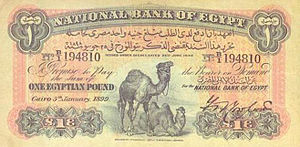British currency in the Middle East
This article includes a list of general references, but it lacks sufficient corresponding inline citations. (September 2009) |
The history and development of British currency in the Middle East emerged from the 19th century.
At first,
Introduction
For nearly four hundred years, silver
In 1825, the
The
Middle East
The situation as regards currency in the British territories in the Middle East was quite different from the situation as regards the currencies of the British West Indies.
East Africa and the Middle East were late additions to the British Empire, and by then, the British government had already learned from experience in Canada, India and Hong Kong that it is highly impractical to impose a new currency in the place of already existing practices.
The sterling unit of account entered the Middle East through Palestine, in the form of the Palestine pound, which was introduced into Palestine in 1927 to end the confusion that had arisen as a result of the twin circulation of Turkish and Egyptian money in the territory. The Palestine pound was created at par with the pound sterling, but it was not used in conjunction with the pounds, shillings and pence coinage. It was used in conjunction with a decimal system.
In the Middle East,
The Palestine pound was also used in Transjordan where it later became referred to as the dinar. The name dinar then became the preferred name for the pound sterling unit of account as it spread to other Middle East territories. Iraq adopted the dinar in 1931 to replace the Indian rupee that had been introduced by the British during the First World War.
Meanwhile, after the First World War, the price of silver rose dramatically. In
In 1970, The
The currency units that are used in Israel, Jordan, Iraq, Kuwait, Bahrain, Oman, and the Yemen are all descended from the pound sterling, while the currency units that are used in Saudi Arabia, Qatar, and the United Arab Emirates are all descended from the Maria Theresa Thaler. This largely explains the factor of ten difference in value on average between Bahrain, Kuwait and Oman on the one hand, and Saudi Arabia, Qatar, and the United Arab Emirates on the other hand. Bahrain, Kuwait and Oman are using units that are descended from sterling, whereas Saudi Arabia, Qatar, and the United Arab Emirates are using units that are descended from the Maria Theresa Thaler.
Cyprus
The British introduced
Initially the Cyprus pound was divided into 20
Egypt

The Egyptian pound (known as the geneih) replaced the Egyptian piastre in 1834, with 100 piastre = 1 pound. The Egyptian pound was also used in Anglo-Egyptian Sudan between 1899 and 1956, and Cyrenaica when it was under British occupation and later an independent emirate between 1942 and 1951. It also circulated in Mandatory Palestine from 1918 to 1927, when the Palestine pound was introduced.
Palestine

Following the institution of the British Mandate for Palestine in 1918, the Egyptian pound was introduced into Palestine, and circulated alongside the Ottoman lira. To end the confusion that had arisen as a result of the twin circulation of Turkish and Egyptian money in the territory, in 1927 the British authorities established the Currency Board for Palestine, which introduced the Palestine pound, equal in value to the pound sterling, which was legal tender in Mandatory Palestine and in Transjordan.
The Currency Board was dissolved in May 1948, with the end of the British Mandate, but the Palestinian pound continued in circulation for a transitional period:
- Israel adopted the Israeli pound (or Israeli lira) in 1952.
- Jordan adopted the Jordanian dinar in 1949.
- In the West Bank, the Palestine pound continued to circulate until 1950, when the West Bank was annexed by Jordan, and the Jordanian dinar became legal tender there.
- In the Gaza Strip, the Palestine pound continued to circulate until April 1951, when it was replaced by the Egyptian pound, three years after the Egyptian army took control of the territory.
Sterling area
At the outbreak of the
As a result of the sterling devaluation of November 1967, the floating of the pound sterling in June 1972, and the ending of the Bretton Woods system of fixed exchange rates that was introduced in 1944, none of the currencies mentioned above retain any fixed parity to any of the sterling units of account. There is no visible relationship between these currencies today and the currency that is used in the United Kingdom.
See also
- British currency in Oceania
- British currency in the South Atlantic and the Antarctic
- British currency in the West Indies
- British currency in West Africa
- East African shilling
- Old Israeli shekel
- Palestine pound
- South Yemeni dinar
References
- Chalmers, R., "A History of Currency in the British Colonies" (1893)


